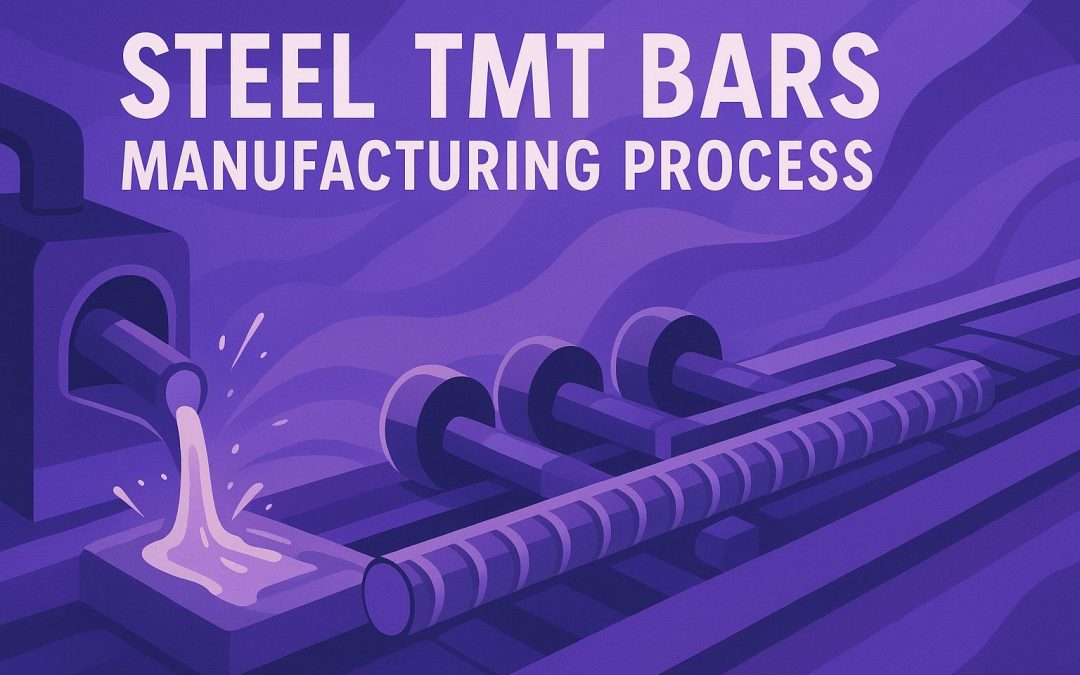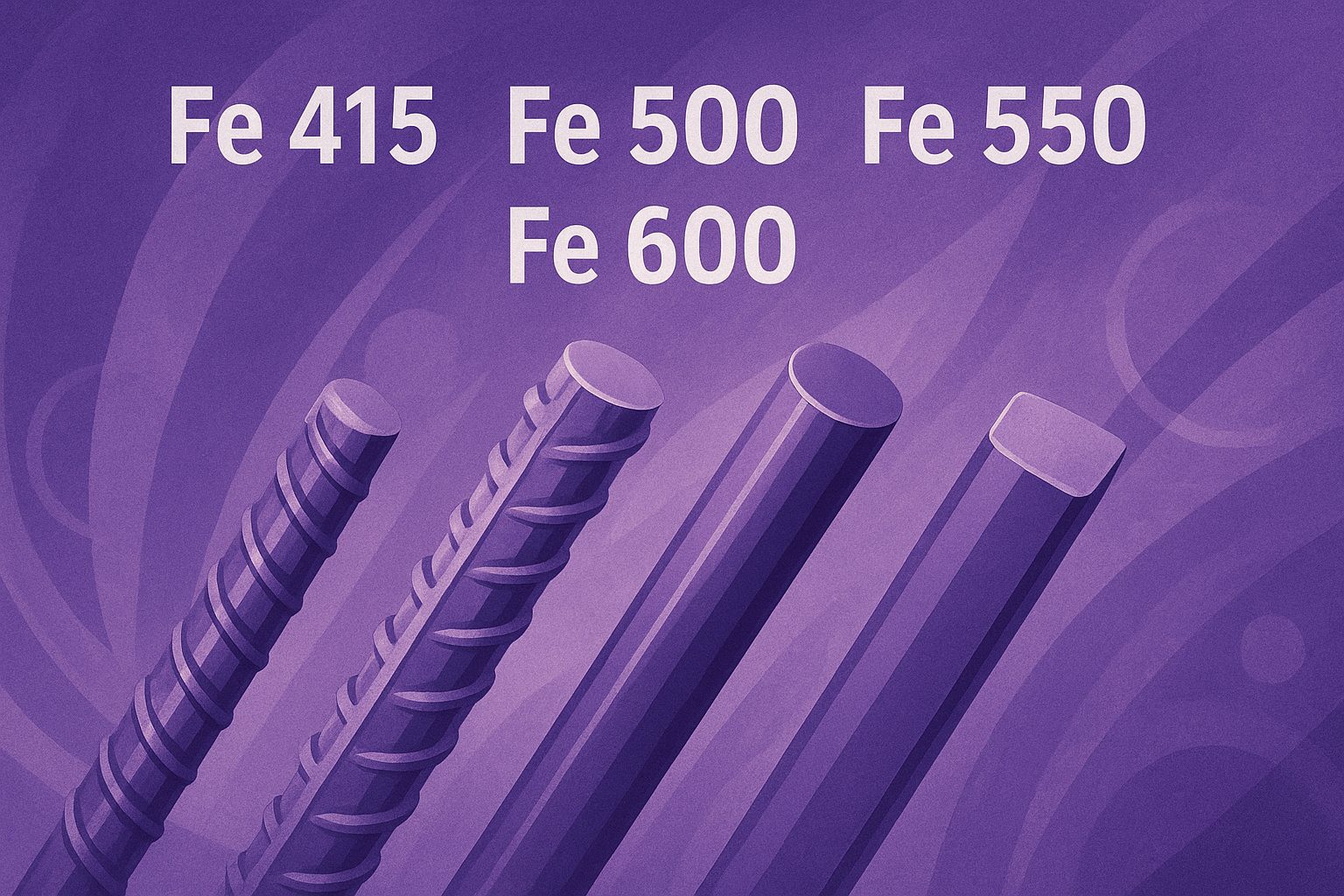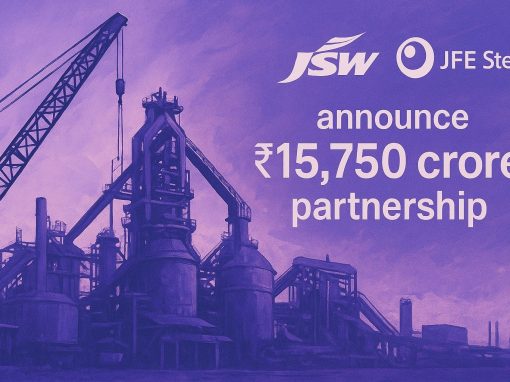Table of Contents
TMT or Thermo Mechanical Treatment is a modern process followed to make high-strength TMT steel bars. These next-generation construction materials play a crucial role in shaping global infrastructure — from bridges and highways to commercial complexes and urban housing. As of 2025, the global TMT bar market continues to expand, driven by rapid infrastructure development and technological advances in automation and green steel manufacturing.
TMT bars are known for their exceptional strength, ductility, weldability, and flexibility, meeting the highest construction standards worldwide. With sustainability becoming a core focus, the TMT bar manufacturing process 2025 emphasises energy-efficient production methods and eco-friendly practices. These bars form the structural backbone of modern architecture, supporting the load-bearing frameworks of residential, industrial, and public infrastructure projects across the globe.
(Also read: Unit weight of TMT bars – 8mm to 32mm)
Advantages of using TMT Bars in construction:
- Lightweight and easy to transport
- Flexible
- Can withstand fires and earthquakes
- Superior malleability, ductility, strength, and weldability
- Recyclable and reusable without loss of quality
Manufacturing Process of Steel TMT Bars
The manufacturing process of steel TMT bars is a technically advanced metallurgical operation that combines mechanical deformation (compression, forging, and rolling) with thermal treatments (heating, quenching, and tempering). TMT refers to the Thermo-Mechanical Treatment process where steel rods are heated to high temperatures and rapidly cooled to form a hard outer layer called martensite, ensuring superior strength and ductility.
Let us take a detailed look at the four key stages in the TMT bar manufacturing process:
Heating, Rolling, and Forming
This is the initial stage where steel billets (produced from iron ore and refined into steel) are heated to about 1200°C–1250°C in a reheating furnace. The billets are then passed through rolling mill stands to achieve the desired size and shape of reinforced steel bars. Continuous innovation in steel-making and rolling technology enhances the strength, consistency, and durability of modern TMT bars.
Quenching
Once the hot rolled bars exit the final mill stand, they immediately pass through a quenching box, where pressurised water jets rapidly cool their outer surface. This sudden cooling forms a hard surface layer called martensite, while the core remains hot and malleable. Quenching improves the tensile strength, wear resistance, and durability of the bars.
Self-tempering
After quenching, the inner core, still at high temperature, transfers heat to the surface, tempering the outer martensitic layer. This process forms tempered martensite, which balances hardness and ductility, giving the bars high mechanical strength without brittleness.
Atmospheric Cooling
In the final stage, the bars are laid out on a cooling bed, where they undergo natural air cooling. This step equalises the temperature between the tough outer shell and the softer core, creating a composite microstructure of strong outer martensite and ductile inner ferrite-pearlite. The result is a TMT bar that is strong, weldable, and earthquake-resistant.
Summary of TMT Bar Manufacturing Process
| Step | Process | Approximate Temperature (°C) | Purpose | Outcome |
| Heating & rolling | Steel billets are heated and rolled into desired shapes | 1200–1250 | Achieve required bar dimensions. | Uniformly formed hot steel bars. |
| Quenching | Rapid cooling using pressurised water jets | 850–900 (surface) | Form hard outer martensite layer. | High tensile strength & surface hardness. |
| Self-tempering | Core heat tempers outer martensite | 400–600 | Achieve balance between strength & ductility. | Tempered martensite structure. |
| Atmospheric cooling | Bars cooled naturally on cooling bed | Ambient | Equalise core and surface temperature. | Ductile core, tough outer layer. |
The quality of TMT bars ultimately depends on three major factors:
- Quality of raw materials (steel billets)
- Precision of the rolling mill and temperature control
- Efficiency of quenching and tempering systems
Through these four systematic stages, the TMT bar manufacturing process ensures the production of high-performance steel bars suited for today’s infrastructure and construction needs.
Technical Details
TMT bars are manufactured in various grades based on their yield strength and ductility, making them suitable for different structural and load-bearing applications. The most widely used grades are Fe 415, Fe 500, Fe 550, and Fe 600, where “Fe” denotes iron and the number represents the minimum yield strength in megapascals (MPa).
The chemical composition of TMT bars is carefully controlled to achieve a balance between strength, ductility, and weldability. Typical composition includes carbon (0.20–0.25%), manganese (0.5–0.8%), sulphur (≤0.05%), phosphorus (≤0.05%), and silicon (0.15–0.3%). This composition ensures that the bars resist fatigue, corrosion, and cracking under extreme conditions.
All TMT bars in India must conform to the Bureau of Indian Standards (BIS) specification IS 1786:2008, titled High Strength Deformed Steel Bars and Wires for Concrete Reinforcement. Compliance ensures consistency in mechanical strength, dimensional accuracy, and safety performance.
Comparison of TMT Bar Grades (As Per IS 1786:2008)
| TMT Grade | Yield Strength (MPa) | Ultimate Tensile Strength (MPa) | Elongation (%) | Typical Application |
| Fe 415 | ≥ 415 | ≥ 485 | ≥ 14.5 | Low-rise buildings, residential construction. |
| Fe 500 | ≥ 500 | ≥ 545 | ≥ 12 | General construction, mid-rise structures. |
| Fe 550 | ≥ 550 | ≥ 585 | ≥ 10 | Industrial structures, bridges, heavy-duty applications. |
| Fe 600 | ≥ 600 | ≥ 660 | ≥ 8 | High-rise buildings, metro projects, and heavy infrastructure. |
These graded specifications enable engineers and builders to select the most suitable TMT bar for their project’s load-bearing requirements and seismic conditions. In 2025, advancements in thermo-mechanical processing and green steel technology have further enhanced the strength-to-weight ratio and sustainability of TMT bar production.
Top TMT Bar Manufacturers in India
India’s TMT bar market continues to grow steadily, driven by rapid urbanisation and infrastructure investments under government initiatives like Bharatmala and Smart Cities Mission. The industry is dominated by a few key players known for quality, consistency, and adherence to BIS standards:
- Tata Tiscon – Pioneer in branded TMT bars with advanced corrosion resistance technology.
- JSW Neosteel – Known for high-grade Fe 550D and Fe 600 bars with superior tensile strength.
- SAIL (Steel Authority of India Limited) – Offers a wide range of BIS-certified TMT bars for major infrastructure projects.
- Vizag Steel (RINL) – Specialises in low-carbon, high-ductility TMT bars.
- SRMB Steel – Recognised for thermo-mechanically treated bars with earthquake-resistant properties.
Conclusion
The TMT bar manufacturing process ensures unmatched strength and flexibility in construction steel. Each step, from billet heating to quenching and cooling, is designed for structural reliability. Modern technologies in TMT production improve energy efficiency and sustainability. Indian manufacturers continue to set global standards for Fe 500 and Fe 600 TMT bars, with steel TMT bars remaining the backbone of India’s growing infrastructure.
Looking to procure steel?
Tata nexarc helps manufacturers, builders and MSMEs source certified steel products, compare prices, and choose the right grade as per IS codes—with complete traceability and procurement confidence.
FAQs
What are TMT bars?
How are TMT bars made?
What makes TMT bars strong?
What are the main grades of TMT bars?
Which grade of TMT bar is best for high-rise buildings?
What standard governs TMT bar quality in India?
What materials are used to make TMT bars?
Why are TMT bars preferred in construction?
Who are the top TMT bar manufacturers in India (2025)?
How is the TMT bar industry evolving in 2025?
Priyanka is a seasoned content marketing professional with more than 6 years of experience crafting various forms of business and technology sector content. Her insightful writing tackles critical issues faced by small-scale manufacturing businesses. Priyanka's clear and concise communication empowers businesses to make informed decisions and thrive in today's dynamic business environment.






The growing demand for TMT bars in the construction industry is interesting I’m curious to see how technological advancements in manufacturing could impact the future of this market.